Dynamics of the Thermal Environment in Climate-Controlled Poultry Houses for Broiler Chickens
Abstract
:1. Introduction
2. Materials and Methods
2.1. Characterization of the Site and the Installation
2.2. Operation of the Climate-Controlled Production System
2.3. Animals Housed and Measurement of Environmental Variables
2.4. Spatialization of Environmental Comfort Indices
2.5. Productive Responses
3. Results and Discussion
4. Study Constraints and Functional Impacts
5. Conclusions
Author Contributions
Funding
Data Availability Statement
Acknowledgments
Conflicts of Interest
References
- Associação Brasileira de Proteína Animal (ABPA). Relatório Anual 2024; ABPA: São Paulo, Brazil, 2024; Available online: https://abpa-br.org/wp-content/uploads/2024/04/ABPA-Relatorio-Anual-2024_capa_frango.pdf (accessed on 11 June 2024).
- Oliveira Júnior, A.J.; Sousa, G.S.; Dal Pai, E.; Almeida, O.C.P.; Mollo Neto, M.; Simões, R.P.; Lucas de Souza, S.R. System for assessing broilers thermal comfort. Smart Agric. Technol. 2021, 1, 100007. [Google Scholar] [CrossRef]
- Ribeiro, B.P.V.; Yanagi Junior, T.; de Oliveira, D.D.; de Lima, R.R.; Zangeronimo, M.G. Thermoneutral zone for laying hens based on environmental conditions, enthalpy and thermal comfort indexes. J. Therm. Biol. 2020, 93, 102678. [Google Scholar] [CrossRef]
- Medeiros, B.B.L.; Moura, D.J.; Massari, J.M.; Curi, T.M.R.C.; Maia, A.P.A. Uso de geoestatística na avaliação de variáveis ambientais em galpão de suínos criados em sistema “wean to finish” na fase de terminação. Eng. Agríc. 2014, 34, 800–811. [Google Scholar] [CrossRef]
- Garcia, R.G.; Lima, N.D.S.; Naas, I.A.; Caldara, F.R.; Sgavioli, S. The typology of broiler house and the impact in the locomotion of broilers. Eng. Agríc. 2018, 38, 326–333. [Google Scholar] [CrossRef]
- Pan, K.F.; Siqueira, J.A.C.; de Souza, S.N.M.; Tokura, L.K.; Nogueira, C.E.C.; Dieter, J.; Caneppele, F.L. Evaluation of broiler dark house illumination systems, with and without thermal insulation. Res. Soc. Dev. 2021, 10, e170101220155. [Google Scholar] [CrossRef]
- Curi, T.M.R.C.; Silva, A.M.; Lima, M.A.; Santos, D.M. Geoestatística para a avaliação do controle ambiental do sistema de ventilação em instalações comerciais para frangos de corte. Eng. Agríc. 2014, 34, 1062–1074. [Google Scholar] [CrossRef]
- Carvalho, T.M.R.; Ribeiro, J.F.; Oliveira, A.F. Qualidade da cama e do ar em diferentes condições de alojamento de frangos de corte. Pesq. Agropec. Bras. 2011, 46, 351–361. [Google Scholar] [CrossRef]
- Liu, L.; Ren, M.; Ren, K.; Jin, Y.; Yan, M. Heat stress impacts on broiler performance: A systematic review and meta-analysis. Poult. Sci. 2020, 99, 6205–6211. [Google Scholar] [CrossRef]
- Andretta, I.; Kipper, M.; Schirmann, G.; Franceschina, C.; Ribeiro, A. Modeling the performance of broilers under heat stress. Poult. Sci. 2021, 100, 101338. [Google Scholar] [CrossRef]
- Wu, X.Y.; Wang, F.Y.; Chen, H.X.; Dong, H.L.; Zhao, Z.Q.; Si, L.F. Chronic heat stress induces lung injury in broiler chickens by disrupting the pulmonary blood-air barrier and activating TLRs/NF-κB signaling pathway. Poult. Sci. 2023, 102, 103066. [Google Scholar] [CrossRef]
- Saeed, M.; Abbas, G.; Alagawany, M.; Kamboh, A.A.; Abd El-Hack, M.E.; Khafaga, A.F.; Sun, C. Heat stress management in poultry farms: A comprehensive overview. J. Therm. Biol. 2019, 84, 414–425. [Google Scholar] [CrossRef] [PubMed]
- Skomorucha, I.; Sosnówka-Czajka, E. Effect of rearing technology on production performance, selected blood parameters, and welfare levels of broiler chickens during the summer production cycle. Ann. Anim. Sci. 2024, 24, 939–948. [Google Scholar] [CrossRef]
- Sumanu, V.O.; Naidoo, V.; Oosthuizen, M.C.; Chamunorwa, J.P. Adverse effects of heat stress during summer on broiler chickens production and antioxidant mitigating effects. Int. J. Biometeorol. 2022, 66, 2379–2393. [Google Scholar] [CrossRef] [PubMed]
- Omomowo, O.O.; Falayi, F.R. Temperature-Humidity Index and Thermal Comfort of Broilers in Humid Tropics. Agric. Eng. Int. CIGR J. 2021, 23, 101. Available online: http://www.cigrjournal.org (accessed on 11 June 2024).
- Rostagno, M.H. Effects of heat stress on the gut health of poultry. J. Anim. Sci. 2020, 98, skaa090. [Google Scholar] [CrossRef]
- El-Sabrout, K.; Sherasiya, A.; Ahmad, S.; Aggag, S.; Nannoni, E.; Cavallini, D.; Buonaiuto, G. Environmental Enrichment in Rabbit Husbandry: Comparative Impacts on Performance and Welfare. Animals 2024, 14, 2367. [Google Scholar] [CrossRef]
- Vastolo, A.; Serrapica, F.; Cavallini, D.; Fusaro, I.; Atzori, A.S.; Todaro, M. Editorial: Alternative and novel livestock feed: Reducing environmental impact. Front. Vet. Sci. 2024, 11, 1441905. [Google Scholar] [CrossRef]
- Felini, R.; Cavallini, D.; Buonaiuto, G.; Bordin, T. Assessing the impact of thermoregulatory mineral supplementation on thermal comfort in lactating Holstein cows. Vet. Anim. Sci. 2024, 24, 100363. [Google Scholar] [CrossRef]
- dos Santos Harada, É.; Montanhani ME, S.; de Freitas Bueno, L.G.; Neto, M.M.; de Souza SR, L.; da Fonseca, R. Árvores de decisão baseadas em entalpia para avaliação de conforto para poedeiras leves em clima tropical. Res. Soc. Dev. 2021, 10, e45310313354. [Google Scholar] [CrossRef]
- Jongbo, A.O.; Atta, A.T. State-of-the-art technologies for assessing thermal comfort of broiler chickens. Int. J. Eng. Appl. Sci. Technol. 2019, 4, 72–83. [Google Scholar] [CrossRef]
- Thom, E.C. The discomfort index. Weatherwise 1959, 12, 57–59. [Google Scholar] [CrossRef]
- Buffington, D.E.; Collasso-Arocho, A.; Canton, G.H. Black Globe-Humidity Index (BGHI) as Comfort Equation for Dairy Cows. Trans. ASAE 1981, 24, 711–714. [Google Scholar] [CrossRef]
- Rodrigues, V.C.; Silva, I.J.O.; Vieira, F.M.C.; Nascimento, S.T. A correct enthalpy relationship as thermal comfort index for livestock. Int. J. Biometeorol. 2010, 55, 455–459. [Google Scholar] [CrossRef] [PubMed]
- Pecoraro, C.A.; Gonçalves, J.C.; Nunes, E.H.; Bumbieris Junior, V.H.; Tavares Filho, J.; Miranda, K.O.S. Enthalpy as a thermal comfort index in broiler poultry production. Rev. Bras. Eng. Agric. Ambient. 2024, 28, e270399. [Google Scholar] [CrossRef]
- de Sá Júnior, A.; de Carvalho, L.G.; Da Silva, F.F.; de Carvalho Alves, M. Application of the Köppen classification for climatic zoning in the state of Minas Gerais, Brazil. Theor. Appl. Climatol. 2012, 108, 1–7. [Google Scholar] [CrossRef]
- Bachmaier, M.; Backes, M. Variogram or semivariogram? Understanding the variances in a variogram. Precis. Agric. 2008, 9, 173–175. [Google Scholar] [CrossRef]
- de Mello, C.R.; Viola, M.R. Mapeamento de chuvas intensas no estado de Minas Gerais. Rev. Bras. Ciênc. Solo 2013, 37, 37–44. [Google Scholar] [CrossRef]
- Cambardella, C.A.; Moorman, T.B.; Novak, J.M.; Parkin, T.B.; Karlen, D.L.; Turco, R.F.; Konopka, A.E. Field scale variability of soil properties in Central Iowa soils. Soil Sci. Soc. Am. J. 1994, 58, 1501–1511. [Google Scholar] [CrossRef]
- Faustino, A.C.; Turco, S.H.N.; Silva Junior, R.G.C.; Miranda, I.B.; Anjos, I.E.; Lourençoni, D. Variabilidade espacial da entalpia e da iluminância em galpões de frangos caipiras. Rev. Bras. Eng. Agríc. Ambient. 2021, 25, 340–344. [Google Scholar] [CrossRef]
- Guesine, G.D.; Silveira, R.M.F.; Silva, I.J.O. Spatial modeling via geostatistics of the bed in a compost barn system: Thermal performance assessments. Int. J. Biometeorol. 2023, 67, 1775–1788. [Google Scholar] [CrossRef]
- Bournet, P.E.; Boulard, T. Effect of ventilator configuration on the distributed climate of greenhouses: A review of experimental and CFD studies. Comput. Electron. Agric. 2010, 74, 195–217. [Google Scholar] [CrossRef]
- Xue, Z.; Fang, X.; Wang, W.; An, S. Soil Organic Carbon Distribution Under Different Land Uses and Landscape Positions in Two Typical Watersheds of the Loess Plateau, China. Nat. Environ. Pollut. Technol. 2014, 13, 693–700. [Google Scholar]
- Infantino, M.; Smerzini, C.; Lin, J. Spatial Correlation of Broadband Ground Motions from Physics-Based Numerical Simulations. Earthq. Eng. Struct. Dyn. 2021, 50, 2575–2594. [Google Scholar] [CrossRef]
- Szatmári, G.; Pásztor, L.; Heuvelink, G.B.M. Estimating Soil Organic Carbon Stock Change at Multiple Scales Using Machine Learning and Multivariate Geostatistics. Geoderma 2021, 403, 115356. [Google Scholar] [CrossRef]
- Oliveira, C.E.A.; Tinôco, I.D.F.F.; de Oliveira, V.C.; Rodrigues, P.H.D.M.; Silva, L.F.D.; Damasceno, F.A.; Andrade, R.R.; Sousa, F.C.D.; Barbari, M.; Bambi, G. Spatial Distribution of Bedding Attributes in an Open Compost-Bedded Pack Barn System with Positive Pressure Ventilation in Brazilian Winter Conditions. Animals 2023, 13, 786. [Google Scholar] [CrossRef]
- Valente, G.F.; Ferraz, G.A.E.S.; Santana, L.S.; Ferraz, P.F.P.; Mariano, D.D.C.; Dos Santos, C.M.; Okumura, R.S.; Simonini, S.; Barbari, M.; Rossi, G. Mapping Soil and Pasture Attributes for Buffalo Management through Remote Sensing and Geostatistics in Amazon Biome. Animals 2022, 12, 2374. [Google Scholar] [CrossRef]
- Silva, M.A.J.G.; Ferraz, P.F.P.; Santos, L.M.D.; Ferraz, G.A.E.S.; Rossi, G.; Barbari, M. Effect of the Spatial Distribution of the Temperature and Humidity Index in a New Zealand White Rabbit House on Respiratory Frequency and Ear Surface Temperature. Animals 2021, 11, 1657. [Google Scholar] [CrossRef]
- Ferraz, P.F.P.; Ferraz, G.A.S.; Schiassi, L.; Nogueira, V.H.B.; Barbari, M.; Damasceno, F.A. Spatial variability of litter temperature, relative air humidity and skin temperature of chicks in a commercial broiler house. Agron. Res. 2019, 17, 408–417. [Google Scholar] [CrossRef]
- Silva, R.A.; Siqueira, G.M.; Costa, M.K.L.; Guedes Filho, O.; Silva, Ê.F.F. Spatial Variability of Soil Fauna Under Different Land Use and Managements. Rev. Bras. Ciênc. Solo 2018, 42, e0170121. [Google Scholar] [CrossRef]
- Guedes, L.P.C.; Bach, R.T.; Uribe-Opazo, M.A. Nugget Effect Influence on Spatial Variability of Agricultural Data. Eng. Agríc. 2020, 40, 96–104. [Google Scholar] [CrossRef]
- Seidel, E.; Oliveira, M. Uma classificação para um índice geoestatístico de dependência espacial. Rev. Bras. Ciênc. Solo 2016, 40, e0160007. [Google Scholar] [CrossRef]
- Silva, I.M.; Pandorfi, H.; Almeida, G.L.P.; Guiselini, C.; Caldas, A.M.; Jacob, A.L. Análise espacial das condições térmicas do ambiente pré-ordenha de bovinos leiteiros sob regimes de climatização. Rev. Bras. Eng. Agríc. Ambient. 2012, 16, 903–909. [Google Scholar] [CrossRef]
- Santos, C.; Matsunaga, A.; Costa, L.; Santos, M.; Neto, A.; Rodrigues, R.; Melo, V. Variabilidade espacial da fertilidade do solo sob sistema agroflorestal e floresta nativa na Amazônia oriental, Brasil. Biosci. J. 2023, 39, e39015. [Google Scholar] [CrossRef]
- Küçüktopcu, E.; Cemek, B. Modelling indoor environmental conditions in a commercial broiler house. J. Agric. Sci. 2019, 25, 440–448. [Google Scholar] [CrossRef]
- Ferraz, P.F.P.; Yanagi Junior, T.; Ferraz, G.A.S.; Schiassi, L.; Campos, A.T. Variabilidade Espacial da Entalpia em Galpões Avícolas na Fase de Aquecimento. Rev. Bras. Eng. Agríc. Ambient. 2016, 20, 570–575. [Google Scholar] [CrossRef]
- Carvalho, T.M.R.; Moura, D.J.; Souza, Z.M.; Souza, G.S.; Bueno, L.G.F.; Lima, K.A.O. Use of Geostatistics on Broiler Production for Evaluation of Different Minimum Ventilation Systems During Brooding Phase. Rev. Bras. Zootec. 2012, 41, 194–202. [Google Scholar] [CrossRef]
- Santos, M.P.; Deniz, M.; Tenffen de Sousa, K.; Klein, D.R.; Branco, T.; Pacheco, P.S.; Martinez do Vale, M. Efficiency of Cooling Systems in Broiler Houses During Hot Days. Ciênc. Rural 2021, 51, e20200941. [Google Scholar] [CrossRef]
- Lopes, I.; da Silva, M.V.; de Melo, J.M.M.; de, A. Montenegro, A.A.; Pandorfi, H. Geostatistics Applied to the Environmental Mapping of Aviaries. Rev. Bras. Eng. Agríc. Ambient. 2020, 24, 409–414. [Google Scholar] [CrossRef]
- Tedeschi, L.O. Assessment of the Adequacy of Mathematical Models. Agric. Syst. 2006, 89, 225–247. [Google Scholar] [CrossRef]
- Medeiros, C.M.; Baêta, F.C.; Oliveira, R.F.M.; Tinôco, I.F.F.; Albino, L.F.T.; Cecon, P.R. Efeitos da Temperatura, Umidade Relativa e Velocidade do Ar em Frangos de Corte. Eng. Agric. 2005, 13, 277–286. [Google Scholar]
- Ferraz, P.F.P.; Yanagi Junior, T.; Ferraz, G.A.S.; Damasceno, F.A. Distribuição Espacial do Índice de Temperatura do Globo e Umidade em Galpão de Frangos na Primeira Semana de Vida Aquecido por Fornalha Industrial. Energ. Agric. 2017, 32, 356–363. [Google Scholar] [CrossRef]
- Abreu, L.H.P.; Yanagi, T.; Bahuti, M.; Lima, R.R.; Lourençoni, D.; Fassani, É.J. Performance of Broilers Submitted to Different Intensities and Duration of Thermal Stress. Dyna 2019, 86, 131–137. [Google Scholar] [CrossRef]
- Soliman, A.; Safwat, A.M. Climate Change Impact on Immune Status and Productivity of Poultry as Well as the Quality of Meat and Egg Products. In Climate Change Impacts on Agriculture and Food Security in Egypt; Omran, E.-S.E., Negm, A.M., Eds.; Springer Water: Berlin/Heidelberg, Germany, 2020; pp. 1–12. [Google Scholar] [CrossRef]
- Aviagen. Ross Manual de Manejo de Frangos de Corte; Aviagen: Huntsville, AL, USA, 2018. [Google Scholar]
- Apalowo, O.O.; Ekunseitan, D.A.; Fasina, Y.O. Impact of Heat Stress on Broiler Chicken Production. Poultry 2024, 3, 107–128. [Google Scholar] [CrossRef]
- Lourençoni, D.; Yanagi Junior, T.; Abreu, P.G.D.; Campos, A.T.; Yanagi, S.D.N. Productive Responses from Broiler Chickens Raised in Different Commercial Production Systems—Part I: Fuzzy Modeling. Eng. Agríc. 2019, 39, 1–10. [Google Scholar] [CrossRef]
- Ponciano, P.F.; Yanagi Junior, T.; Schiassi, L.; Campos, A.T.; Nascimento, J.W.B. Sistema fuzzy para predição do desempenho produtivo de frangos de corte de 1 a 21 dias de idade. Eng. Agríc. 2012, 32, 446–458. [Google Scholar] [CrossRef]
- Cândido, M.G.; Tinôco, I.D.F.; Pinto, F.D.A.D.C.; Santos, N.T.; Roberti, R.P. Determination of thermal comfort zone for early-stage broilers. Eng. Agríc. 2016, 36, 760–767. [Google Scholar] [CrossRef]
- Silva, E.T.; Leite, D.G.; Yuri, F.M.; Nery, F.S.G.; Rego, J.C.C.; Zanatta, R.A.; dos Santos, S.A.; Moura, V.V. Determinação do índice de temperatura e umidade (ITU) para produção de aves na mesorregião metropolitana de Curitiba—PR. Rev. Acad. Ciênc. Agrár. Ambient. 2004, 2, 47–60. [Google Scholar] [CrossRef]
- Furtado, D.A.; Dantas, R.T.; Nascimento, J.W.B.; Santos, J.T.; Costa, F.G.P. Efeitos de diferentes sistemas de acondicionamento ambiente sobre o desempenho produtivo de frangos de corte. Rev. Bras. Eng. Agríc. Ambient. 2006, 10, 484–489. [Google Scholar] [CrossRef]
- Ferraz, P.F.P.; Yanagi Junior, T.; Melo, L.F.L.D.; Castro, J.D.O.; Cecchin, D. Spatial and temporal distribution of enthalpy in aviary heated by industrial furnace. Rev. Ceres 2018, 65, 346–355. [Google Scholar] [CrossRef]
- Martinez, A.A.G.; Nääs, I.D.A.; Abe, J.M.; Pereira, D.F. A Mobile Application to Follow Up the Management of Broiler Flocks. AgriEngineering 2021, 3, 990–1000. [Google Scholar] [CrossRef]
- Silva, R.B.T.R.; de Nääs, I.A.; de Oliveira Júnior, A.J.; dos Reis, J.G.M.; Lima, N.D.D.S.; de Souza, S.R.L. Improving the Management of Poultry Production: Mobile Application Development and Validation. Res. Soc. Dev. 2020, 9, e4019108806. [Google Scholar] [CrossRef]
- Wasti, S.; Sah, N.; Mishra, B. Impact of Heat Stress on Poultry Health and Performances, and Potential Mitigation Strategies. Animals 2020, 10, 1266. [Google Scholar] [CrossRef] [PubMed]
- Barbosa Filho, J.A.D.; Vieira, F.M.C.; Garcia, D.B.; Silva, M.A.N.; Silva, I.J.O. Mudanças e uso das Tabelas de Entalpia; Piracicaba: São Paulo, Brazil, 2007; Available online: http://www.nupea.esalq.usp.br/ (accessed on 5 June 2024).
- Moghadam, A.; Thippareddi, H.; Pidaparti, R. Machine Learning Model for Assuring Bird Welfare during Transportation. AgriEngineering 2022, 4, 367–379. [Google Scholar] [CrossRef]
- Queiroz, M.L.V.; Barbosa Filho, J.A.D.; Sales, F.A.L.; Lima, L.R.; Duarte, L.M. Variabilidade Especial do Ambiente em Galpões de Frango de Corte com Sistema de Nebulização. Ciênc. Agron. 2017, 48, 586–595. Available online: https://www.scielo.br/j/rca/a/9p9TyxyY7zvD8zXWLxynM6K/?format=pdf&lang=pt (accessed on 5 June 2024).
- Gonçalves, I.C.M.; Turco, S.H.N.; Lopes Neto, J.P.; Nascimento, J.W.B.; Lima, V.L.A.; Borges, V.P. Thermal Performance of Aviary Located in the Semiarid Region of Pernambuco Based on Computer Simulation. Rev. Bras. Eng. Agríc. Ambient. 2022, 26, 533–540. [Google Scholar] [CrossRef]
- Brito, A.N.S.L.; Lopes Neto, J.P.; Furtado, D.A.; Mascarenhas, N.M.H.; Oliveira, A.G.; Gregório, M.G.; Dornelas, K.C.; Laurentino, L.G.S.; Rodrigues, H.C.S. Desempenho Térmico de Galpões Avícolas para Frangos de Corte: Revisão Sobre os Diferentes Tipos de Coberturas. Res. Soc. Dev. 2020, 9, e474997608. [Google Scholar] [CrossRef]
- Cobb-Vantress. Cobb500TM Suplemento de Nutrição e Desempenho do Frango de Corte; CobbCares: Siloam Springs, AR, USA, 2022; Available online: https://www.cobbgenetics.com/assets/Cobb-Files/2022-Cobb500-Broiler-Performance-Nutrition-Supplement.pdf (accessed on 5 June 2024).
- Rubio, A.A.; Hess, J.B.; Berry, W.D.; Dozier, W.A.; Pacheco, W.J. Effects of Corn Particle Size on Broiler Performance During the Starter, Grower, and Finisher Periods. J. Appl. Poult. Res. 2020, 29, 352–361. [Google Scholar] [CrossRef]
- Yerpes, M.; Llonch, P.; Manteca, X. Factors Associated with Cumulative First-Week Mortality in Broiler Chicks. Animals 2020, 10, 310. [Google Scholar] [CrossRef]
- Van Limbergen, T.; Sarrazin, S.; Chantziaras, I.; Dewulf, J.; Ducatelle, R.; Kyriazakis, I.; McMullin, P.; Méndez, J.; Niemi, J.K.; Papasolomontos, S.; et al. Risk factors for poor health and performance in European broiler production systems. BMC Vet. Res. 2020, 16, 287. [Google Scholar] [CrossRef]
- Santos, G.R.; Reati, L.A.; Dias, E.H.; Dorneles, I.C.; Mezalira, T.S.; Otutumi, L.K. Percentage of Condemnations of Broiler Carcasses Related to Lineage and Breeding System. Ciênc. Anim. 2019, 29, 12–21. Available online: https://revistas.uece.br/index.php/cienciaanimal/article/view/9889 (accessed on 5 June 2024).
- Ozkan, M.; Simsek, U.G. The effect of light/dark cycles on performance and welfare in broiler. Ann. Anim. Sci. 2022, 22, 795–802. [Google Scholar] [CrossRef]
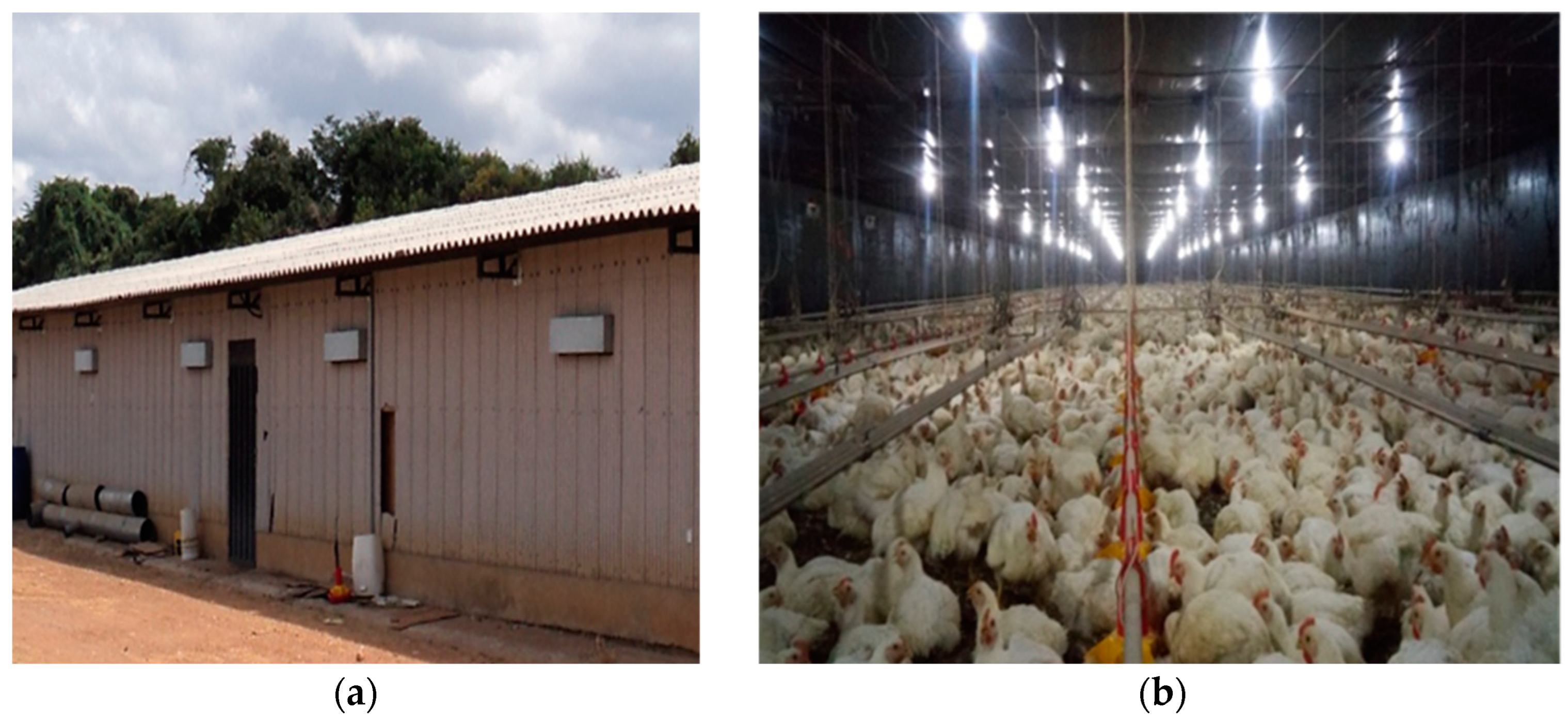


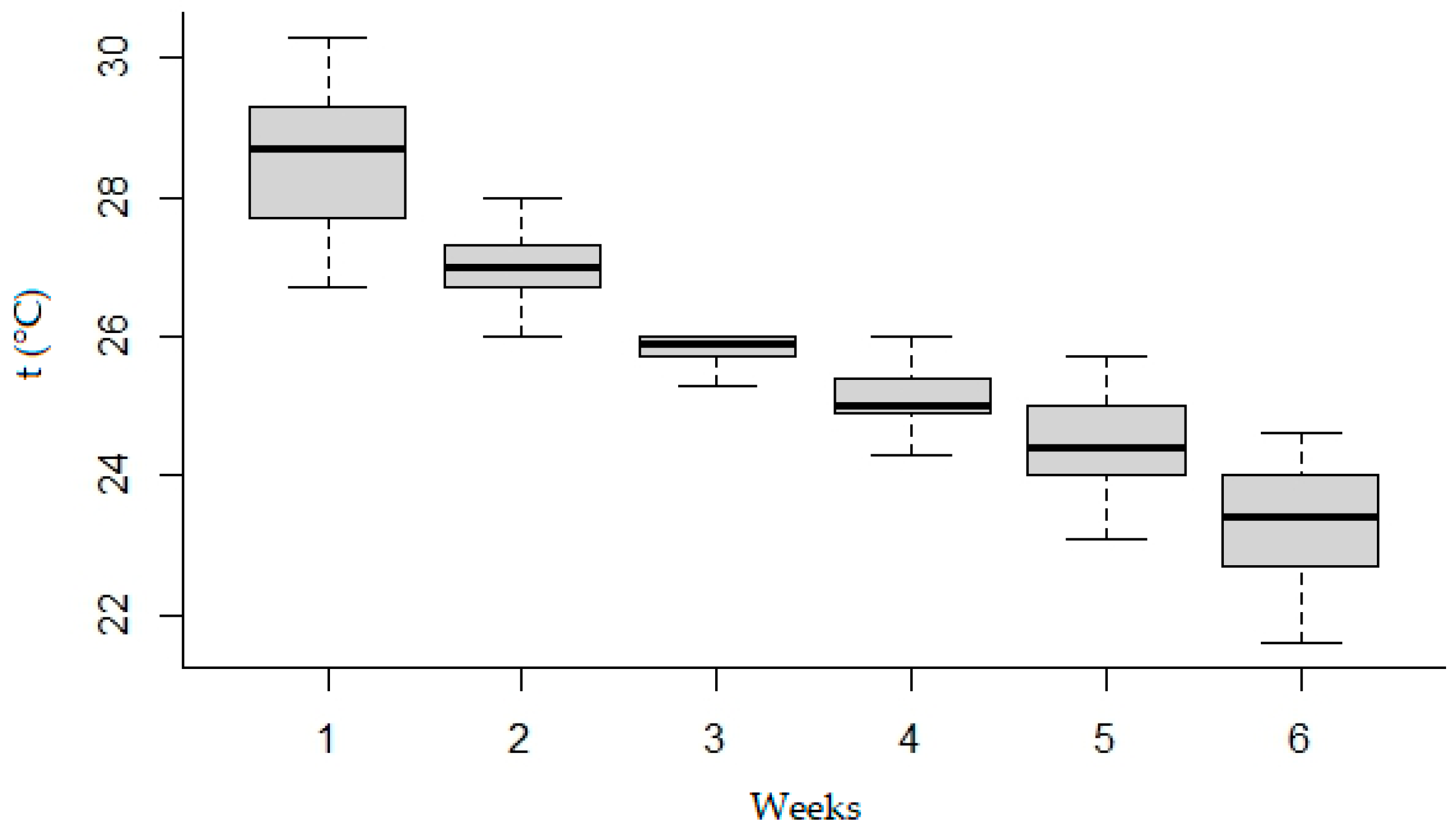


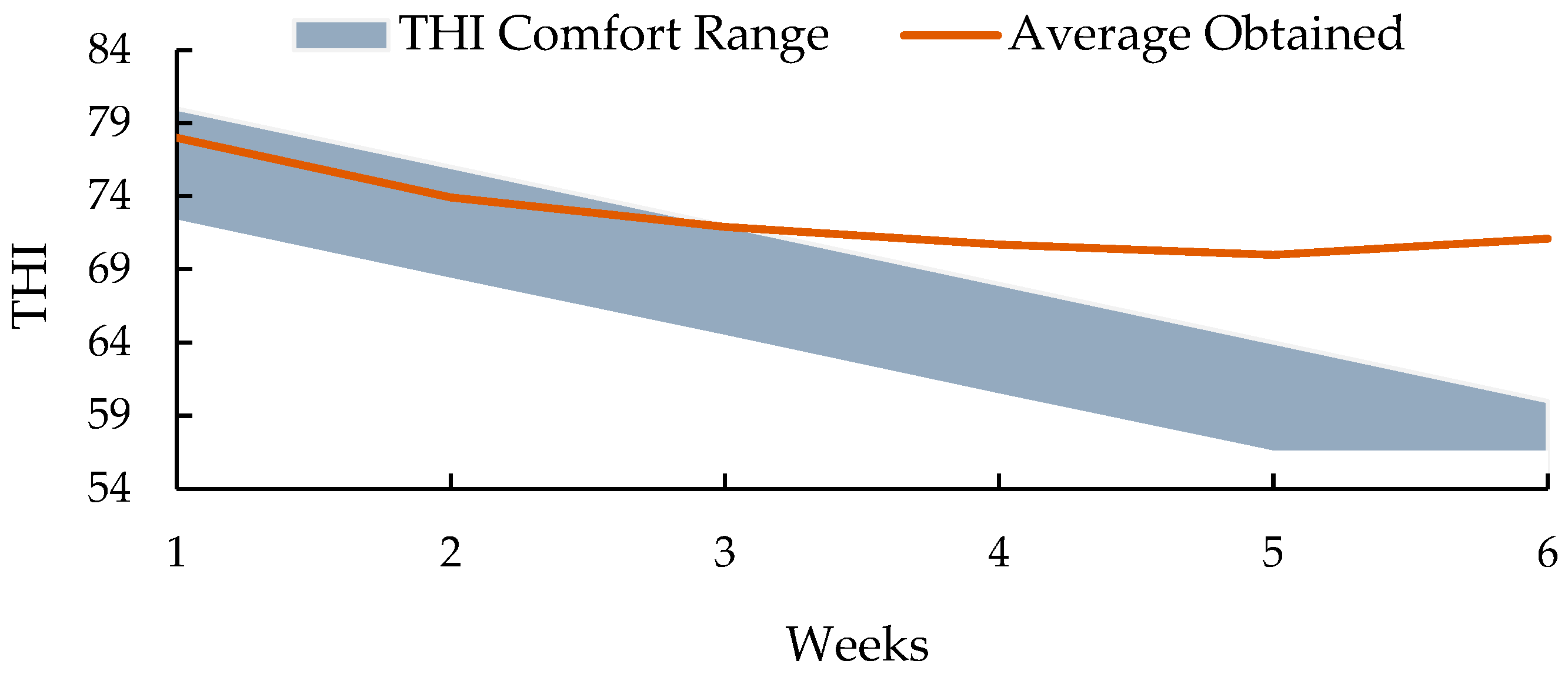
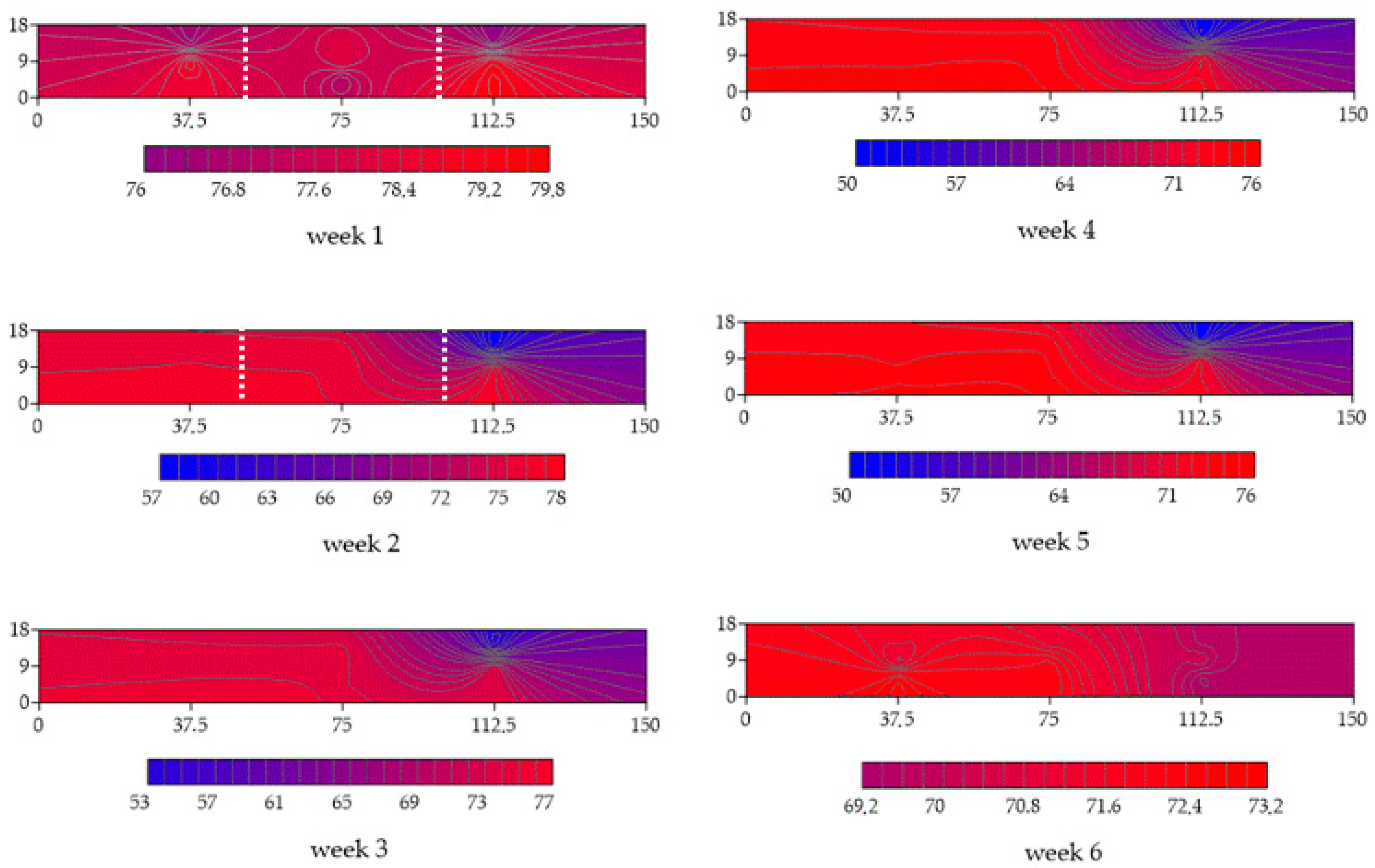
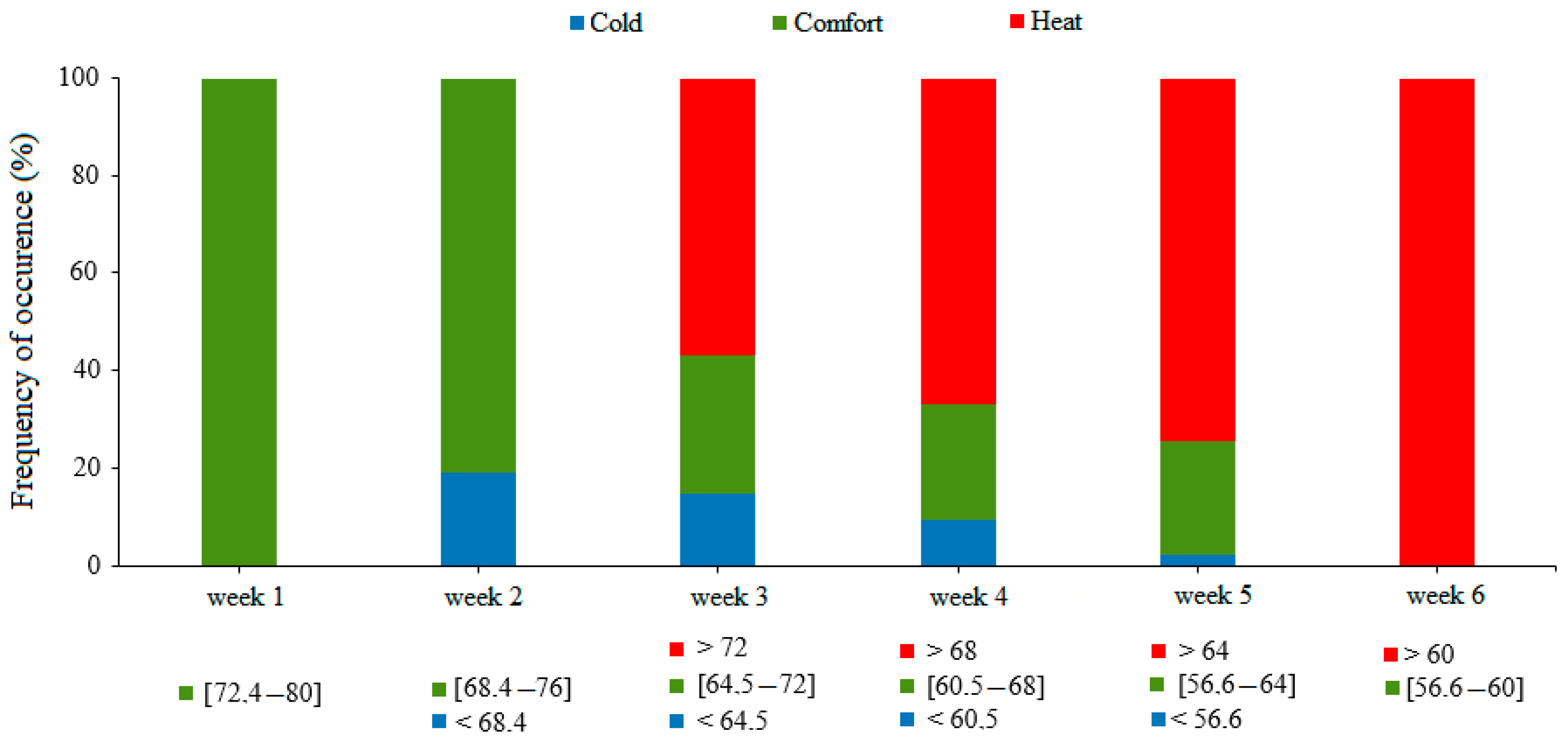



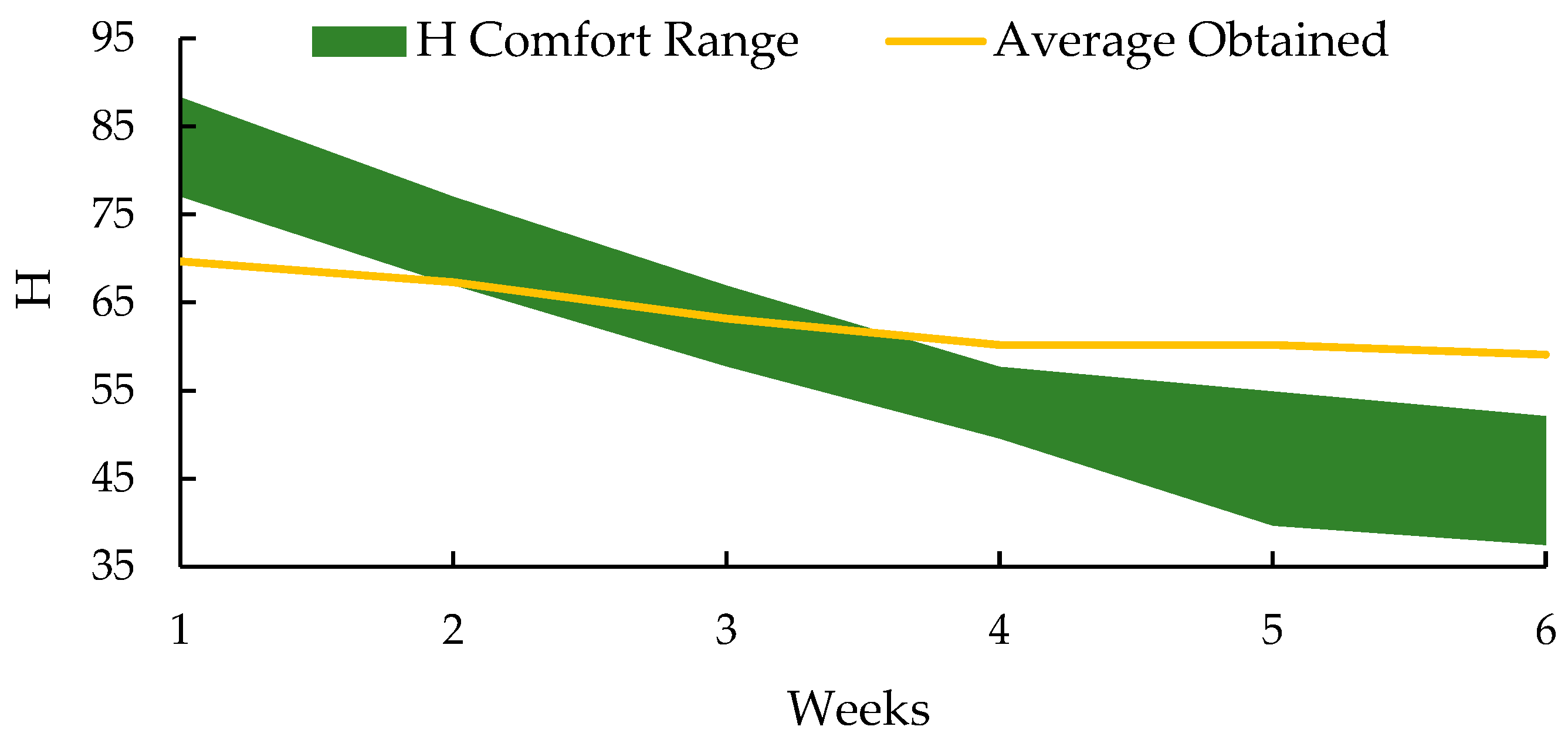

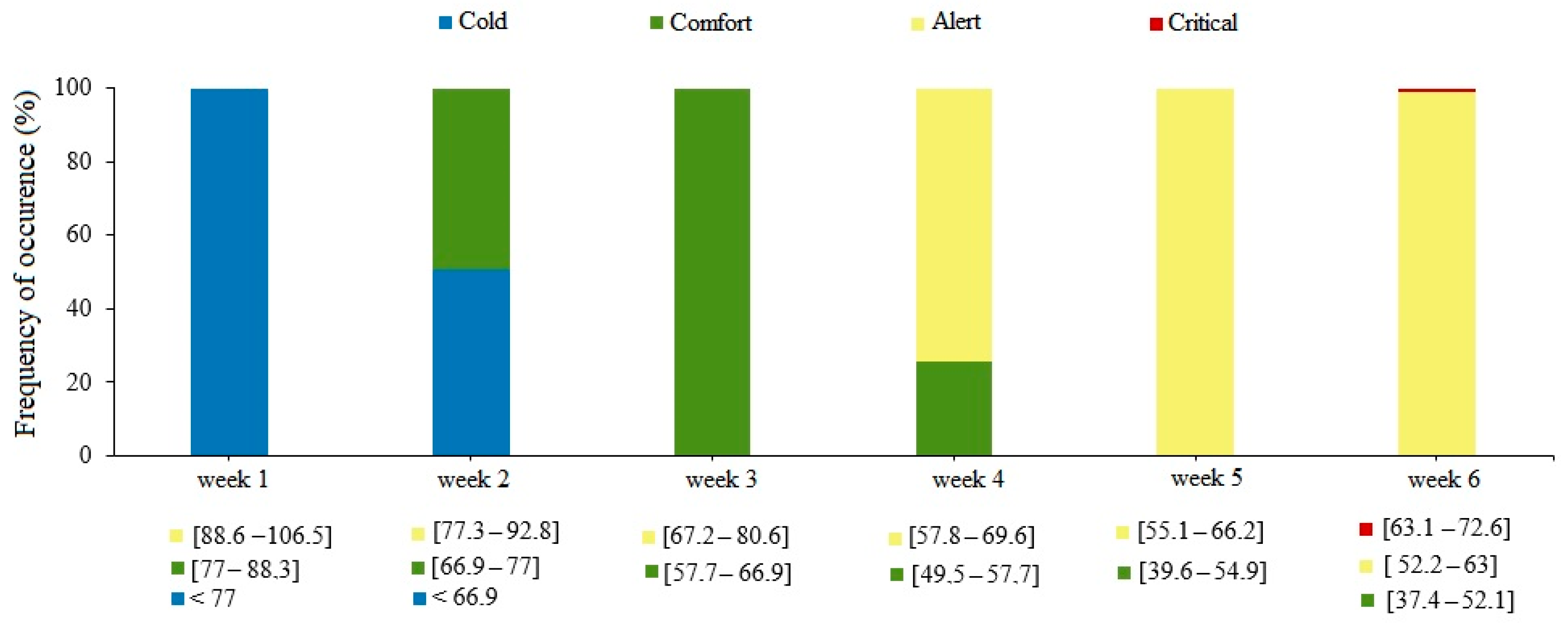
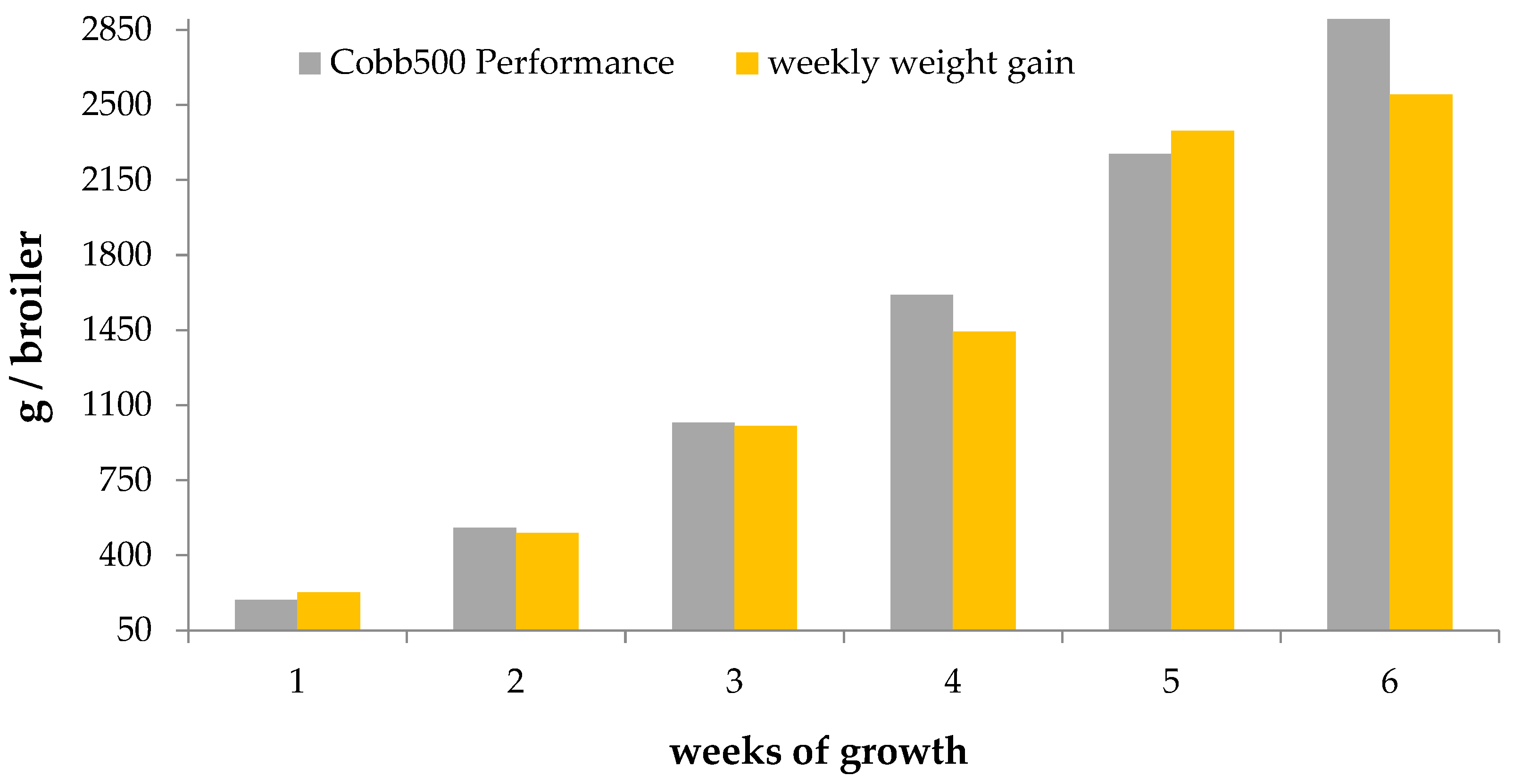
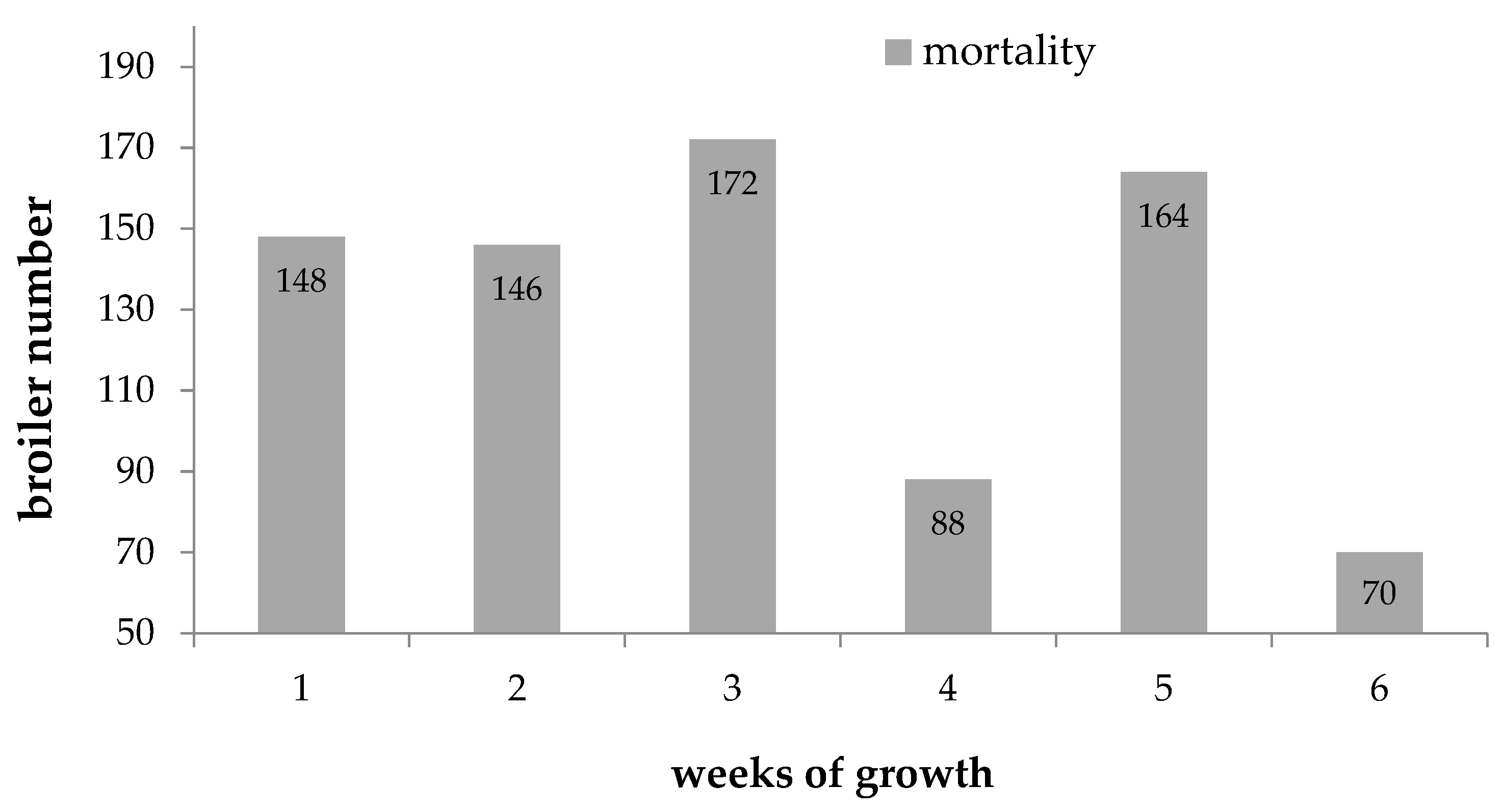
| Variable | Week | Mean | Median | CV (%) 1 | Asymmetry | Kurtosis | SD 2 |
|---|---|---|---|---|---|---|---|
| t (°C) | 1 | 28.6 | 28.7 | 4.35 | −0.22 | −1.12 | 1.25 |
| 2 | 27.0 | 27.0 | 2.21 | −0.06 | −0.51 | 0.60 | |
| 3 | 25.8 | 25.9 | 1.86 | 0.06 | −0.03 | 0.48 | |
| 4 | 25.0 | 25.0 | 2.54 | −0.26 | −0.51 | 0.64 | |
| 5 | 24.4 | 24.4 | 3.39 | −0.06 | −0.78 | 0.83 | |
| 6 | 23.3 | 23.4 | 4.14 | −0.35 | −0.82 | 0.97 | |
| RH (%) | 1 | 59.1 | 58.4 | 6.53 | 1.19 | 1.12 | 3.86 |
| 2 | 63.7 | 64.6 | 5.90 | −0.55 | −1.15 | 3.76 | |
| 3 | 64.2 | 64.1 | 1.66 | −0.16 | −0.28 | 1.06 | |
| 4 | 62.8 | 62.9 | 1.34 | 0.16 | −1.58 | 0.84 | |
| 5 | 67.1 | 66.9 | 1.13 | 0.30 | −0.62 | 0.76 | |
| 6 | 71.8 | 71.6 | 1.09 | 0.03 | −1.21 | 0.78 | |
| THI | 1 | 78.0 | 78.2 | 1.61 | −0.41 | −1.23 | 1.25 |
| 2 | 73.9 | 76.0 | 8.55 | −2.45 | 4.05 | 6.31 | |
| 3 | 71.9 | 74.2 | 9.71 | −2.45 | 4.05 | 6.98 | |
| 4 | 70.7 | 73.3 | 10.76 | −2.43 | 4.00 | 7.60 | |
| 5 | 70.0 | 72.5 | 10.92 | −2.42 | 3.97 | 7.64 | |
| 6 | 71.1 | 71.2 | 1.67 | −0.09 | −1.16 | 1.19 | |
| BGHI | 1 | 80.8 | 80.6 | 2.50 | 0.85 | 0.69 | 2.02 |
| 2 | 78.1 | 78.1 | 0.54 | −0.58 | −0.37 | 0.42 | |
| 3 | 76.4 | 76.6 | 0.71 | 0.01 | −1.55 | 0.54 | |
| 4 | 75.1 | 75.3 | 1.12 | 0.13 | −1.34 | 0.84 | |
| 5 | 74.2 | 74.3 | 1.43 | 0.22 | −1.47 | 1.06 | |
| 6 | 72.7 | 72.6 | 1.57 | 0.48 | −1.38 | 1.14 | |
| H (kJ/kg) | 1 | 69.7 | 69.1 | 6.28 | 0.29 | −1.12 | 4.38 |
| 2 | 67.3 | 66.9 | 2.90 | 0.10 | −1.23 | 1.95 | |
| 3 | 63.2 | 63.3 | 3.01 | −0.17 | −0.59 | 1.90 | |
| 4 | 60.2 | 60.7 | 3.45 | −0.38 | −0.58 | 2.08 | |
| 5 | 60.2 | 60.4 | 4.12 | −0.34 | −0.87 | 2.48 | |
| 6 | 59.1 | 59.0 | 5.39 | −0.05 | −1.14 | 3.18 |
| Variable | Week | Model | (C0) | (C0 + C1) | A0 | A | DSD | SSR | R2 | |
|---|---|---|---|---|---|---|---|---|---|---|
| t (°C) | 1 | Gaussian | 0.32 | 1.66 | 22.98 | 39.8 | 19.4 | Strong | 7.6 | 0.22 |
| 2 | Exponential | 0.06 | 0.38 | 13.17 | 41.2 | 16.5 | Strong | 0.011 | 0.93 | |
| 3 | Gaussian | 0.04 | 0.24 | 22.63 | 39.20 | 18.5 | Strong | 0.038 | 0.87 | |
| 4 | Gaussian | 0.11 | 0.44 | 25.75 | 44.60 | 24.7 | Strong | 0.019 | 0.98 | |
| 5 | Exponential | 0.13 | 0.71 | 15.20 | 45.61 | 18.9 | Strong | 1.35 × 10−3 | 0.99 | |
| 6 | Exponential | 0.20 | 1.02 | 13.25 | 39.75 | 19.1 | Strong | 0.056 | 0.97 | |
| RH (%) | 1 | Gaussian | 0.98 | 6.99 | 23.53 | 38.26 | 14.0 | Strong | 10.300 | 0.54 |
| 2 | Gaussian | 0.60 | 15.06 | 22.49 | 38.95 | 4.0 | Strong | 17.200 | 0.98 | |
| 3 | Gaussian | 0.15 | 0.92 | 21.91 | 37.94 | 16.2 | Strong | 0.044 | 0.93 | |
| 4 | Spherical | 0.27 | 0.74 | 38.81 | 38.81 | 36.2 | Moderate | 0.574 | 0.57 | |
| 5 | Gaussian | 0.05 | 0.26 | 11.39 | 19.73 | 19.3 | Strong | 0.006 | 0.72 | |
| 6 | Gaussian | 0.11 | 0.51 | 23.48 | 40.67 | 22.4 | Strong | 0.594 | 0.91 | |
| THI | 1 | Spherical | 0.30 | 1.63 | 38.0 | 38.0 | 18.8 | Strong | 5.870 | 0.27 |
| 2 | Spherical | 0.05 | 0.30 | 38.12 | 38.13 | 15.8 | Strong | 0.029 | 0.55 | |
| 3 | Gaussian | 0.02 | 0.18 | 21.52 | 37.29 | 9.2 | Strong | 6.33 × 10−3 | 0.55 | |
| 4 | Spherical | 0.10 | 0.62 | 41.20 | 41.20 | 15.8 | Strong | 0.031 | 0.84 | |
| 5 | Gaussian | 0.14 | 0.82 | 22.95 | 39.75 | 16.6 | Strong | 0.006 | 0.87 | |
| 6 | Gaussian | 0.30 | 1.47 | 24.04 | 41.64 | 20.5 | Strong | 0.048 | 0.98 | |
| BGHI | 1 | Gaussian | 0.09 | 1.02 | 22.22 | 38.56 | 8.5 | Strong | 1.100 | 0.22 |
| 2 | Spherical | 0.06 | 0.15 | 27.62 | 27.62 | 37.7 | Moderate | 0.037 | 0.41 | |
| 3 | Gaussian | 0.03 | 0.24 | 22.48 | 38.94 | 13.1 | Strong | 4.27 × 10−4 | 0.99 | |
| 4 | Gaussian | 0.01 | 0.41 | 22.36 | 38.73 | 3.2 | Strong | 0.012 | 0.94 | |
| 5 | Gaussian | 0.27 | 1.16 | 22.80 | 39.49 | 23.6 | Strong | 0.093 | 0.82 | |
| 6 | Gaussian | 0.04 | 0.60 | 23.55 | 40.78 | 6.5 | Strong | 0.064 | 0.57 | |
| H (kJ/kg) | 1 | Gaussian | 0.12 | 12.58 | 16.21 | 28.07 | 1.0 | Strong | 0.019 | 0.99 |
| 2 | Spherical | 0.25 | 1.73 | 17.79 | 17.79 | 14.3 | Strong | 4.380 | 0.54 | |
| 3 | Gaussian | 0.32 | 1.72 | 23.70 | 41.05 | 18.5 | Strong | 0.736 | 0.44 | |
| 4 | Gaussian | 0.04 | 0.64 | 25.53 | 44.22 | 6.7 | Strong | 0.129 | 0.44 | |
| 5 | Spherical | 1.33 | 6.27 | 42.61 | 42.61 | 21.2 | Strong | 0.764 | 0.96 | |
| 6 | Spherical | 2.33 | 10.93 | 39.10 | 39.10 | 21.4 | Strong | 2.000 | 0.98 | |
Disclaimer/Publisher’s Note: The statements, opinions and data contained in all publications are solely those of the individual author(s) and contributor(s) and not of MDPI and/or the editor(s). MDPI and/or the editor(s) disclaim responsibility for any injury to people or property resulting from any ideas, methods, instructions or products referred to in the content. |
© 2024 by the authors. Licensee MDPI, Basel, Switzerland. This article is an open access article distributed under the terms and conditions of the Creative Commons Attribution (CC BY) license (https://creativecommons.org/licenses/by/4.0/).
Share and Cite
Ferreira, J.C.; Campos, A.T.; Ferraz, P.F.P.; Bahuti, M.; Junior, T.Y.; Silva, J.P.d.; Ferreira, S.C. Dynamics of the Thermal Environment in Climate-Controlled Poultry Houses for Broiler Chickens. AgriEngineering 2024, 6, 3891-3911. https://doi.org/10.3390/agriengineering6040221
Ferreira JC, Campos AT, Ferraz PFP, Bahuti M, Junior TY, Silva JPd, Ferreira SC. Dynamics of the Thermal Environment in Climate-Controlled Poultry Houses for Broiler Chickens. AgriEngineering. 2024; 6(4):3891-3911. https://doi.org/10.3390/agriengineering6040221
Chicago/Turabian StyleFerreira, Jacqueline Cardoso, Alessandro Torres Campos, Patrícia Ferreira Ponciano Ferraz, Marcelo Bahuti, Tadayuki Yanagi Junior, Joaquim Paulo da Silva, and Sílvia Costa Ferreira. 2024. "Dynamics of the Thermal Environment in Climate-Controlled Poultry Houses for Broiler Chickens" AgriEngineering 6, no. 4: 3891-3911. https://doi.org/10.3390/agriengineering6040221
APA StyleFerreira, J. C., Campos, A. T., Ferraz, P. F. P., Bahuti, M., Junior, T. Y., Silva, J. P. d., & Ferreira, S. C. (2024). Dynamics of the Thermal Environment in Climate-Controlled Poultry Houses for Broiler Chickens. AgriEngineering, 6(4), 3891-3911. https://doi.org/10.3390/agriengineering6040221






